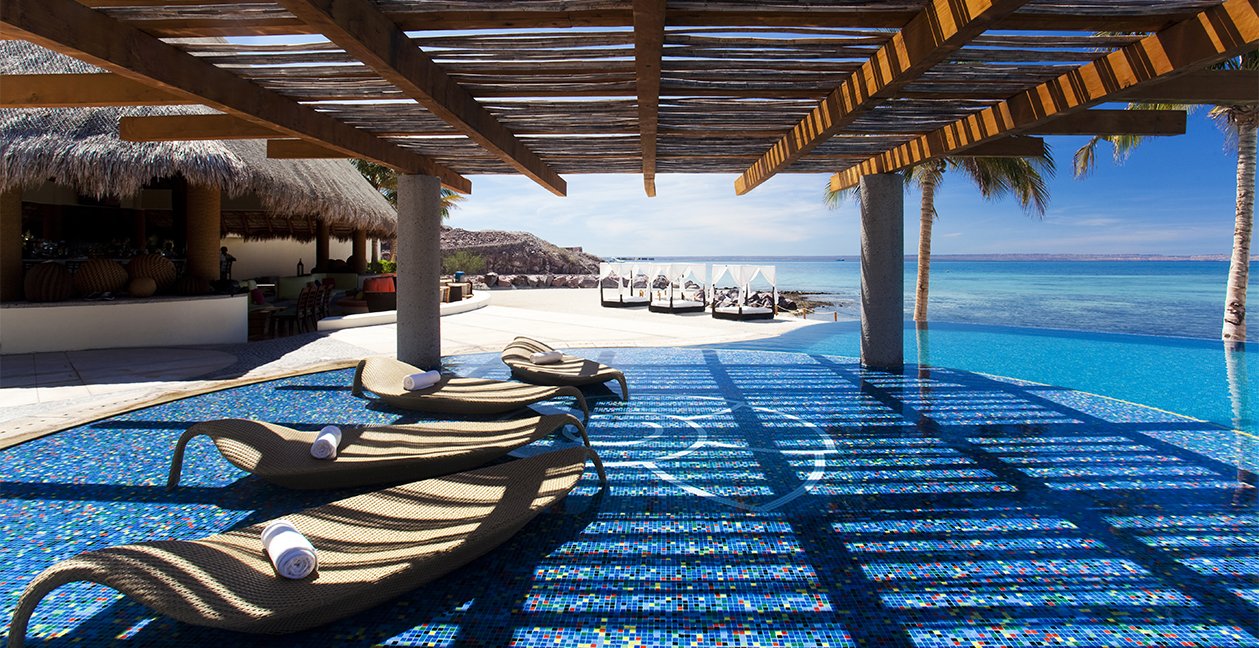Since the 1940s, Baja California has been a quiet draw for literary giants, Hollywood royalty and art superstars, including John Steinbeck, Ernest Hemingway, Desi Arnaz, Lucille Ball, Bing Crosby and John Wayne. American artist Donald Judd credits Baja as the source of his creative inspiration.
The 775-mile-long Mexican peninsula, extending south from San Diego, culminates in its most famous city, Cabo San Lucas. Surprisingly mountainous, the few main highways weave through the valleys. Long stretches of eastern beaches are inaccessible.
Mostly Sonoran Desert, verdant oases create respites from the endless cacti.
Bumping up against these desert shores is the open Pacific on the west and the fabled Sea of Cortez on the east. Jacques Cousteau called the latter, “the aquarium of the world.” Home to 891 fish species and 39 percent of the world’s marine mammal species, it’s no wonder the United Nations has designated the sea a protected area. Mexico agrees and has a comprehensive program to safeguard the whales, whale sharks, porpoises, sea lions and other marine residents.

The most popular Baja destination is Cabo San Lucas, which, unfortunately, is a sea of cement, best known for plentiful margaritas, bachelorette parties and mall-style shopping.
The strip of condos and high-end resorts to the east, known as “the Corridor,” is much tonier. Residences here fetch in the multimillions. In the legendary Palmilla Resort, homes routinely sell for $20 million, a bargain compared to the $50 million George Clooney listed his Cabo home for.
A two hour drive north, centered around Baja’s capital city of La Paz, a different world exists. Billionaires who could live anywhere have quietly settled here. Christy Walton (widow of Walmart heir John Walton), Rodney Lewis (Texas energy entrepreneur), Manuel Arango (Mexican supermarket magnate), John Hargreaves (founder of British department store chain, Matalan) and not-quite-billionaires—like entrepreneur Jeffrey Curtiss, who built both a 24-unit seafront resort and a 1,000-acre working ranch complete with ostriches—now call it home.
Why? Because La Paz is a real city, not a made-for-Americans tourist destination. Yet, it feels completely safe and is free from the constant annoyance Cabo presents of hawkers pushing everything from glass-bottom boat excursions to serapes or camel rides.

The newly renovated three-mile-long, seafront promenade, Malecon, is alive with local families yet easy to navigate while in search of the perfect artisanal ice cream shop with local favorites, such as cactus pear sorbet.
The town, historic buildings intermingled with post-modern ones, is clearly under renovation. Government and private structures are getting facelifts using funds pouring in from a variety of sources, including wealthy Mexican second home buyers and ex-pat Americans and Brits. Yet, La Paz is currently a third of the price of Cabo.
In anticipation of the new sophistication flowing into La Paz, chic restaurants, like Bestia, are changing the dining scene with their “Tribeca style” décor and internationally inspired food.
Sensing the growth potential, boutique, high-end American real estate brokers, such as The Agency, have recently opened offices.
A few minutes south of La Paz is a mega-yacht center. Steven Spielberg’s Seven Seas, Laurene Powell Jobs’ Venus (designed by Philippe Starck) and Ostar, the yacht of Mexico’s richest man Carlos Slim, all spend significant amounts of time at the Puerta Cortés Resort’s marina, Pueblito. All told, some of the world’s largest yachts have visited. Asked why they keep coming, a knowledgeable real estate source said, “They love the privacy. They can walk around unnoticed.”
The inner and outer harbor also has 250 slips for “normal” sized boats. Cruisers from the U.S. West Coast often stay over the winter months.
For those more terra-firma inclined, or without a mega-yacht at their disposal, the Puerta Cortés Resort, the only five-star lodging in La Paz, is a self-contained world. Spread over 200-plus acres, the resort offers an extensive selection of sea-view accommodations plus four pools (one of which is a seaside infinity pool, double Olympic length, where floating pelicans keep swimmers company), three gyms, a beach club with water toys and spa services, as well as a hilltop lounge ideal for cocktails while sunset viewing. Golf carts whisk guests between the extensive facilities.
“I came to Puerta Cortés for my honeymoon and, much to my surprise, fell in love with this place,” explains Antonio Davila, the resort’s owner. “Within a few years, I bought the resort and moved my family here.” Since then, he’s proved his devotion by upgrading everything.
Puerta Cortés has several housing options. For those needing nothing more than a hip hotel room, Costa Baja with its two swimming pools and two dining rooms is the logical choice. Rooms range from standards to waterfront suites with kitchens.
A little up the hill is the semi-circular Vistamar. These ultra-high-end condos, meticulously finished and furnished, start at 2,600-square-feet, including massive water-view terraces. Vistamar has a well-equipped gym, large infinity pool and spacious common areas.
Further up the hill, Las Colinas is a collection of 72 private villas, ranging from two to five bedrooms. It is ideal for families and those wanting privacy.
If golf is your game, the El Cortés course, with its sweeping ocean views, draws some of the world’s top players. According to golf pro Greg Martin, “Gary Player’s courses are known to be challenging, and this one with its wide and narrow, up and down features, stretching over four miles is exceptionally unforgiving.” On the 14th hole, one of the longest par fives in Mexico, players tee off from an elevated cliff.
Overseeing the food, executive chef Christian Morales was trained in Spain by Martín Berasategui (who has more Michelin stars than any other Spanish chef). Morales supervises the 10 dining options, a few of which include: Baja coffee institution Doce Cuarenta, open-kitchen restaurant Steinbeck’s, La Taberna Española and Odayaka, serving luminescent sushi taken moments before from adjacent waters.
Morales is committed to showcasing Baja’s locally farmed produce, renowned free-range beef and plentiful fish.
Best of all, Puerta Cortés is an ideal access point for viewing the Sea of Cortez’s abundant marine life. From its docks, several licensed companies, like BACo, run marine biologist-led tours, where it’s possible to swim right next to 30-feet-long, multi-ton, yet docile, whale sharks and diminutive, playful sea lions, view breeching whales and visit an island reserved for blue herons. Swimming up close and personal with whale sharks is one of life’s unforgettably unique experiences.
When you’re tired of all the wildlife, it’s a short hop to silky sanded Balandra Beach, where the desert meets the sea. Accessible only by boat, the almost surreal turquoise blue water is clear, calm and warm. No services are available to disrupt the serenity, but catered picnic lunches are easily arranged.
Davila intends to use Puerta Cortés as a conduit for introducing guests to the Sea of Cortez. “Anyone who visits, who goes out on the water, falls in love with this place. My job is to create a destination that draws people here.”







